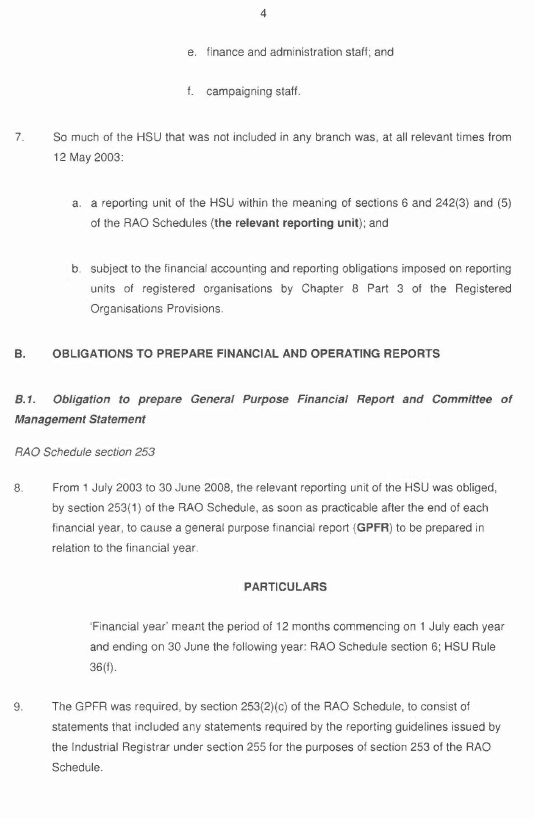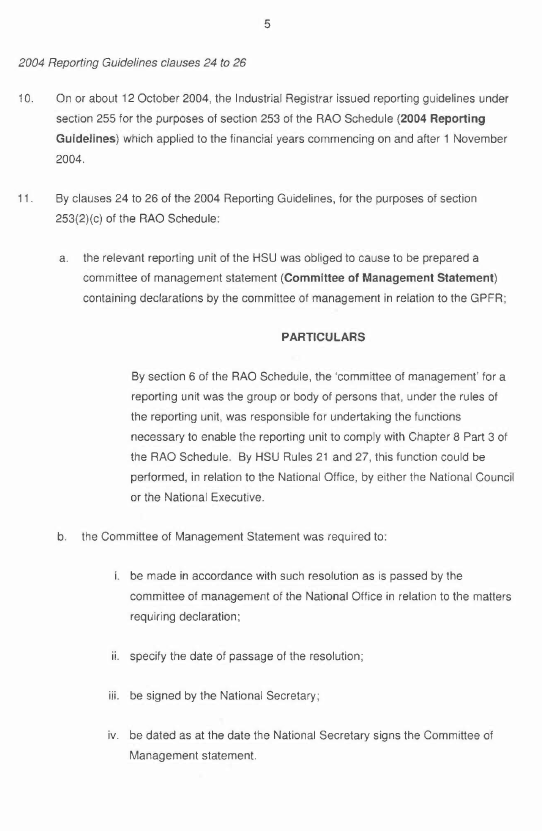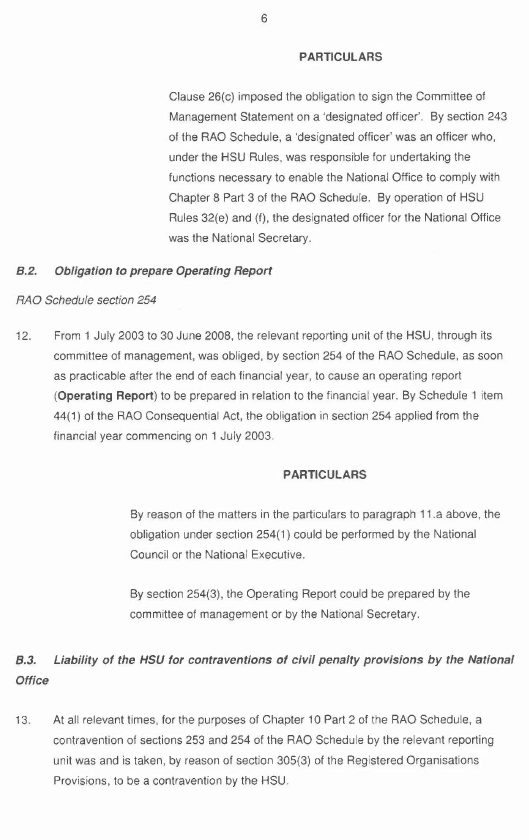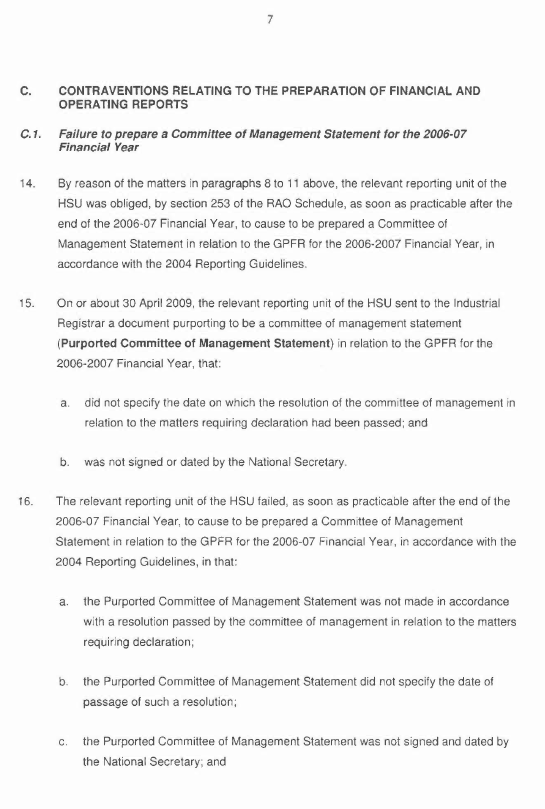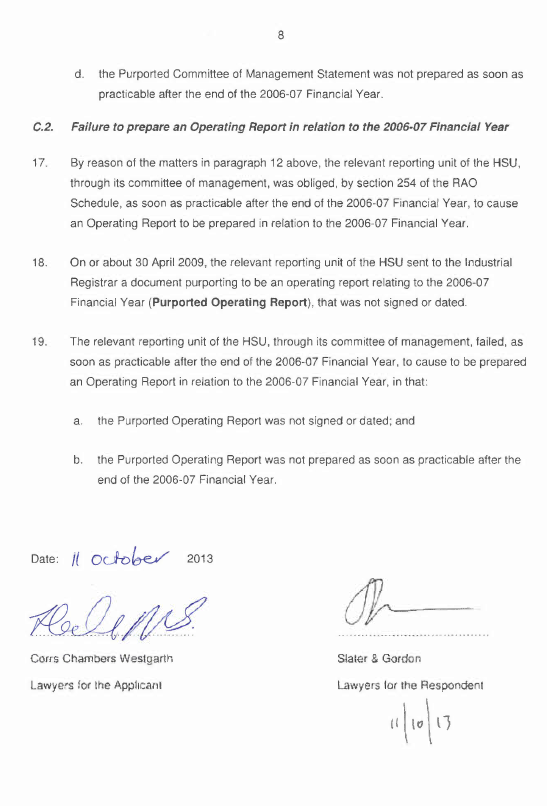FEDERAL COURT OF AUSTRALIA
General Manager of Fair Work Australia v Health Services Union [2013] FCA 1306
|
IN THE FEDERAL COURT OF AUSTRALIA |
|
|
GENERAL MANAGER OF FAIR WORK AUSTRALIA Applicant | |
|
AND: |
Respondent |
|
DATE OF ORDER: |
|
|
WHERE MADE: |
DECLARATIONS:
1. The Health Services Union contravened section 253 in Schedule 1 to the Workplace Relations Act 1996 (Cth) in that it failed, as soon as practicable after the end of the 2006-07 Financial Year, to prepare a Committee of Management Statement for the 2006-07 Financial Year, in accordance with the 2004 Reporting Guidelines.
2. The Health Services Union contravened section 254 in Schedule 1 to the Workplace Relations Act 1996 (Cth) in that it failed, through its Committee of Management, as soon as practicable after the end of the 2006-07 Financial Year, to prepare an Operating Report in relation to that financial year.
THE COURT ORDERS THAT:
1. The Health Services Union pay the Commonwealth of Australia $22,500 within 30 days.
2. The proceeding be otherwise dismissed.
Note: Entry of orders is dealt with in Rule 39.32 of the Federal Court Rules 2011.
|
VICTORIA DISTRICT REGISTRY |
|
|
FAIR WORK DIVISION |
VID 1128 of 2012 |
|
BETWEEN: |
GENERAL MANAGER OF FAIR WORK AUSTRALIA Applicant |
|
AND: |
HEALTH SERVICES UNION Respondent |
|
JUDGE: |
MIDDLETON J |
|
DATE: |
4 DECEMBER 2013 |
|
PLACE: |
MELBOURNE |
REASONS FOR JUDGMENT
introduction
1 The General Manager of the Fair Work Commission (‘the General Manager) has sought pecuniary penalties and declaratory relief against the Health Services Union (‘the HSU’) for failing to prepare operating and financial reports for the 2006-2007 financial year.
2 The parties filed a ‘Statement of Agreed Facts and Admitted Contraventions as Between the Applicant and the Respondent’ (‘Statement of Agreed Facts and Admitted Contraventions’) on 11 October 2013 where the HSU admitted to failing to produce operating and financial reports for the 2006-2007 financial year.
3 Further to the Statement of Agreed Facts and Admitted Contraventions and pursuant to the Court order made on 15 October 2013, the parties filed a ‘Joint Outline of Submissions on Penalty and Other Relief’ (‘the Joint Submissions on Penalty’) on 8 November 2013.
4 In the Joint Submissions on Penalty, the parties agreed that an appropriate civil penalty for the two breaches would be $22,500. They have also agreed on the form of declaratory relief.
5 For the reasons outlined below I have decided to make the civil penalties and declaratory relief substantially as agreed between the parties.
agreed facts
6 The following is taken largely from the Statement of Agreed Facts and Admitted Contraventions which I attach to this judgment marked ‘Annexure A’.
7 The legislative history of the provisions requiring the preparation of financial and operating reports is complicated. When the contraventions occurred the HSU was required to produce financial and operational reports by the Registration and Accountability of Organisation provisions as set out in Schedule 1 to the Workplace Relations Act 1996 (Cth) (‘the RAO Schedule’). From 1 July 2009, the Workplace Relations Act 1996 (Cth) was renamed the Fair Work Act 2009 (Cth), and the RAO Schedule became the body of the Fair Work (Registered Organisations) Act 2009 (Cth) (‘the FWRO Act’), with the section numbers remaining unchanged.
8 Relevantly, s 253(1) of the RAO Schedule required:
As soon as practicable after the end of each financial year, a reporting unit must cause a general purpose financial report to be prepared, in accordance with the Australian Accounting Standards, from the financial records kept under subsection 252(1) in relation to the financial year.
9 Furthermore, s 254(1) of the RAO Schedule required:
As soon as practicable after the end of each financial year, the committee of management of a reporting unit must cause an operating report to be prepared in relation to the financial year.
10 So much of the HSU that was not included in any branch was, at all relevant times from 12 May 2003:
1. A reporting unit of the HSU within the meaning of the relevant provisions of the RAO Schedule; and
2. Subject to the financial accounting and reporting obligations imposed on reporting units of registered organisations by Chapter 8 Part 3 of the RAO Schedule.
11 For simplicity, I shall refer to the relevant reporting unit as the HSU.
12 The General Manager may apply to the Court to make an order imposing a civil penalty on registered organisation for contraventions of the civil penalty provisions.
Contravention of s 253(1) of the RAO Schedule
13 The financial report must contain information as required in the reporting guidelines: ss 253(2) and 255.
14 On or about 12 October 2004, reporting guidelines were issued requiring the HSU to prepare a ‘Committee of Management Statement’ containing declarations by the committee of management in relation to the financial report.
15 On or about 30 April 2009, the HSU provided a Committee of Management Statement relating to the 2006-2007 financial year that was not compliant with the Reporting Guidelines, as particularised in [15]-[16] of Annexure A. As the financial report was non-compliant with the Reporting Guidelines, the HSU contravened s 253(1).
Contravention of s 254(1) of the RAO Schedule
16 On or about 30 April 2009, the HSU provided an operating report relating to the 2006-2007 financial year that was not signed or dated, and not prepared as soon as practicable after the end of the financial year: see [17]-[19] of Annexure A. These deficiencies amounted to a contravention of s 254(1).
agreed pecuniary penalties and declaratory relief
17 The Court has the power to impose civil penalties for contraventions of civil penalty provisions by virtue of s 306 of the FWRO Act. In the case of bodies corporate, of which the HSU is one, not more than 300 penalty units. At the time of the contraventions, a penalty unit was $110, and consequently the maximum penalty is $33,000 for each contravention.
18 It is not unusual for parties to submit agreed civil penalties to the Court in cases like this where the facts have been agreed.
19 Whether or not a court should accept agreed civil penalties has recently attracted controversy with the Court of Appeal of the Supreme Court of Victoria in ASIC v Ingleby [2013] VSCA 49 criticising the approach taken by the Full Federal Court in NW Frozen Foods v Australian Competition and Consumer Commission (1996) 71 FCR 285 and the Minister for Industry, Tourism and Resources v Mobile Oil Australia [2004] FCAFC 72.
20 I considered the authorities in ACCC v AGL Sales [2013] FCA 1030 [12] – [44]. Relevantly for present purposes I concluded that:
[42] …provided the Court has, as it should, an overall view of the considerations relevant to the making of appropriate orders, being given any indication of an agreed position on penalty can be of assistance. This assistance could be given preferably by the providing of an ‘agreed range’, or by separate submission of the parties. In asking whether an agreed figure falls within the range of penalties reasonably available does not mean the court does not need to consider independently the appropriate penalty. It must do so in order to determine whether the range is in fact appropriate. As no one precise penalty figure is necessarily the only appropriate figure, the court will often consider the matter in terms of a permissible range in arriving at a final penalty. Of course, no agreed position, whether it be to a range or agreed figure, can be binding on the court.
[43] I do not believe, despite the comments made by the various justices in the Victorian Court of Appeal, that the reasoning adopted in NW Frozen Foods and Mobil Oil fetters the power of the court to determine the appropriate penalty. Nevertheless, the comments by the justices of the Court of Appeal are a useful reminder of the onerous responsibility placed upon a court in determining the appropriate orders.
21 I adopt what I said in ACCC v AGL Sales with respect to the imposition of agreed civil penalties in the present case.
22 With the above in mind, when the parties have agreed on a penalty, the Court must assess if the penalty is appropriate.
23 I have examined the Agreed Statement of Facts and Admitted Contraventions and believe that it sets out the facts, breaches and admissions sufficiently for me to assess the pecuniary penalty.
24 The principal purpose for the imposition of a financial penalty is deterrence: to deter the contravening party from repeating its contraventions, and more generally deterring others who may have contemplated engaging in similar conduct: Singtel Optus Pty Ltd v ACCC (2012) 287 ALR 249 at [41] and [62]-[64].
25 There are innumerable factors a court must consider when determining an appropriate pecuniary penalty: see for example the factors articulated by Tracey J in Kelly v Fitzpatrick [2007] FCA 1080 at [14].
26 It is important to appreciate that each of the contravened provisions are key to achieving the relevant statutory objectives, including setting standards to “encourage the efficient management of organisations and high standards of accountability of organisations to their members” (s 5(3)(c)).
27 Furthermore, ss 253 and 254 promote transparency and accountability in the financial management of organisations. The information that is required to be provided by these provisions enables the members of an organisation to understand the true financial position of the organisation, such that members are in a position to exercise appropriate control over the management.
28 Mitigating factors include the fact that the two contraventions both arose out of the failure to lodge statements concerning the 2006-2007 financial year; the HSU partially complied with its obligations; and the HSU has been contrite and cooperative, as indicated by joining in the Statement of Agreed Facts and Admitted Contraventions.
29 I have considered the maximum penalties available. I am content that the civil penalty of $22,500 acts as both a deterrent and is appropriate for the contravening conduct. It follows that I am satisfied that the penalty is appropriate and within the permissible range of penalties for breaches of the kind made by the HSU.
30 The parties have also agreed the declarations substantially in the form I propose to make.
31 The Court has discretion to make declarations pursuant to s 21 of the Federal Court of Australia Act 1976 (Cth).
32 I am content that the declarations properly identify the contravening conduct, and making the declarations registers the Court’s disapproval of the contravening conduct.
conclusion
33 For the above reasons, I order that the HSU pay the Commonwealth of Australia $22,500, and declarations be made substantially in the form as proposed by the parties.
|
I certify that the preceding thirty-three (33) numbered paragraphs are a true copy of the Reasons for Judgment herein of the Honourable Justice Middleton. |
Associate:
‘ANNEXURE A’



